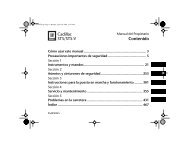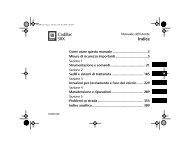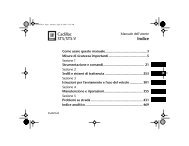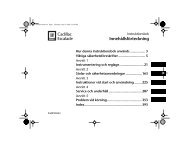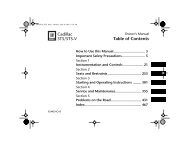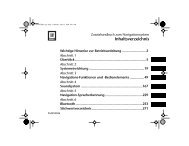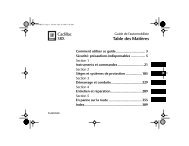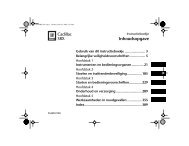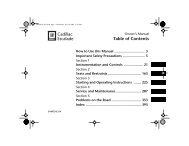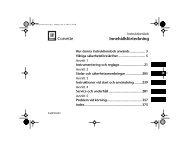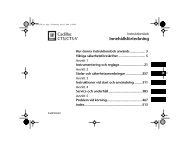Owner's Manual Cadillac BLS - IFS Europe BV
Owner's Manual Cadillac BLS - IFS Europe BV
Owner's Manual Cadillac BLS - IFS Europe BV
You also want an ePaper? Increase the reach of your titles
YUMPU automatically turns print PDFs into web optimized ePapers that Google loves.
460_OM_MY09.book Page 146 Wednesday, April 2, 2008 10:32 AM<br />
146 Starting and driving<br />
Braking<br />
It is good practice to try your brakes periodically<br />
while driving. This is particularly<br />
important when driving in heavy rain, on<br />
roads with a lot of surface water, in snow or<br />
in salty slush. In such conditions a slight<br />
delay in the braking effect may be noticed.<br />
To minimise this delay, dry the brakes by<br />
applying them lightly now and again. This<br />
should also be done after the car has been<br />
washed, and in extremely damp weather.<br />
To avoid the brakes becoming overheated,<br />
such as when negotiating long descents<br />
with a drop of several hundred metres,<br />
select a low gear to utilise the braking effect<br />
of the engine. If the car has automatic transmission,<br />
select 1st or 2nd gear.<br />
You can help to prolong the life of the brakes<br />
by thinking ahead and braking harder over<br />
short periods, rather than braking more<br />
moderately over long stretches.<br />
WARNING<br />
The brake pressure required when the<br />
engine is off, such as when the car is on<br />
tow, is roughly four times the normal<br />
pedal force required. The pedal will feel<br />
hard and unresponsive. The steering will<br />
also be very heavy.<br />
We advise against using wheels with<br />
large ventilation slots in winter, as the<br />
brake components are then more<br />
exposed to slush, road salt and grit.<br />
Overheating can cause the brakes to<br />
fade!<br />
ABS brakes<br />
WARNING<br />
No ABS system can set aside the laws of<br />
physics. The additional safety afforded by<br />
the system is not designed to allow<br />
drivers to drive faster but to make normal<br />
driving safer.<br />
In order to achieve as short a stopping<br />
distance as possible with better handling<br />
on dry, wet and slippery road surfaces,<br />
depress the brake pedal with full force,<br />
declutch and if necessary steer to<br />
safety.<br />
The Antilock Braking System (ABS) modulates<br />
the brake pressure to each wheel. The<br />
pressure is automatically reduced just<br />
before the wheel locks up and then<br />
increases again to the point at which the<br />
wheel is just about to lock. The wheel sensors<br />
send information to the brake system’s<br />
electronic control module for every decimetre<br />
that the car rolls. This information is<br />
processed continuously to ensure that the<br />
adjustment of the brake pressure will be as<br />
exact as possible. Adjustment takes place<br />
up to 12 times per second.




